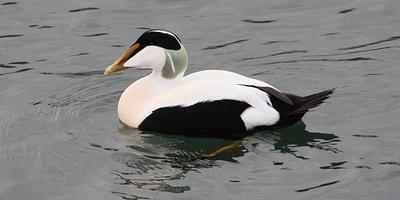
A bird for all seasons
One bird you can see along the coast at any season of the year is the eider – a favourite of mine. The male bird is easy to recognise - very distinctive in his black and white livery and, if you get a good view, look for the attractive pale green around his neck. As always with ducks the female is not so showy as the male, but her brown plumage provides wonderful camouflage when nesting.
At this time of year eiders are gearing up for the all-important breeding season. They have returned from their winter quarters and are about to move onto the islands to nest. The males are crooning their evocative courtship song while displaying eagerly with their ritual head movements. Most females will soon be paired up having selected their mates from the many persistent suitors though their relationship will only be of brief duration. The male bird tries to protect his mate from the attentions of other males but once she has finished laying eggs and started incubation he abandons her to her lonely vigil. She has the demanding job of keeping the eggs warm and safe for four weeks, only leaving the nest briefly twice a day to drink, though not to feed. While away she covers the eggs with the famous eider down which she plucks from her breast, in order to keep the eggs warm and hide them from gulls and crows. The female can lose more than a third of her bodyweight during incubation – what commitment!
_John_Hunt.jpg)
She sits tightly on the nest and can be very hard to spot so, if you do go onto the islands, you have to be very careful not to go too close and panic her into flying off. If that happens you must cover the eggs on her behalf. Increased human presence along the coast is thought to be one reason why very few eiders now nest on the mainland.
_John_Hunt.jpg)
As soon as the eggs hatch the mother leads the chicks down to the sea, running the gauntlet of the predatory gulls and then takes them off to safer rearing places. Within hours of hatching the chicks can walk, swim and dive – skills that they need if they are to survive for long. They may join other chicks in a creche which is protected by several females - this will give their mother a badly needed opportunity to feed. The first two weeks of life are hazardous indeed for the young as they must find food for themselves and learn how to survive in an unfriendly environment.
_John_Hunt2..jpg)
_David_Steel.jpg)
More than 200 female eiders nest on the islands near North Berwick every year – mainly on Craigleith and Fidra. After the incredible time and care devoted to producing young it is sad that all too often very few chicks make it to maturity. However it seems that enough do survive to maintain this important breeding population.
We do not know how long eiders have nested in the Forth but it could be for a very long time. An earlier version of the name Fidra is “Fetheray” which is thought to derive from a Norse expression meaning “Feather Island”. Eider feathers have been harvested for centuries in Iceland and perhaps it is not too fanciful to think that the Vikings valued Fidra for this reason. Whatever happened in the past we must hope that these delightful birds continue to grace our shores.
John Hunt
